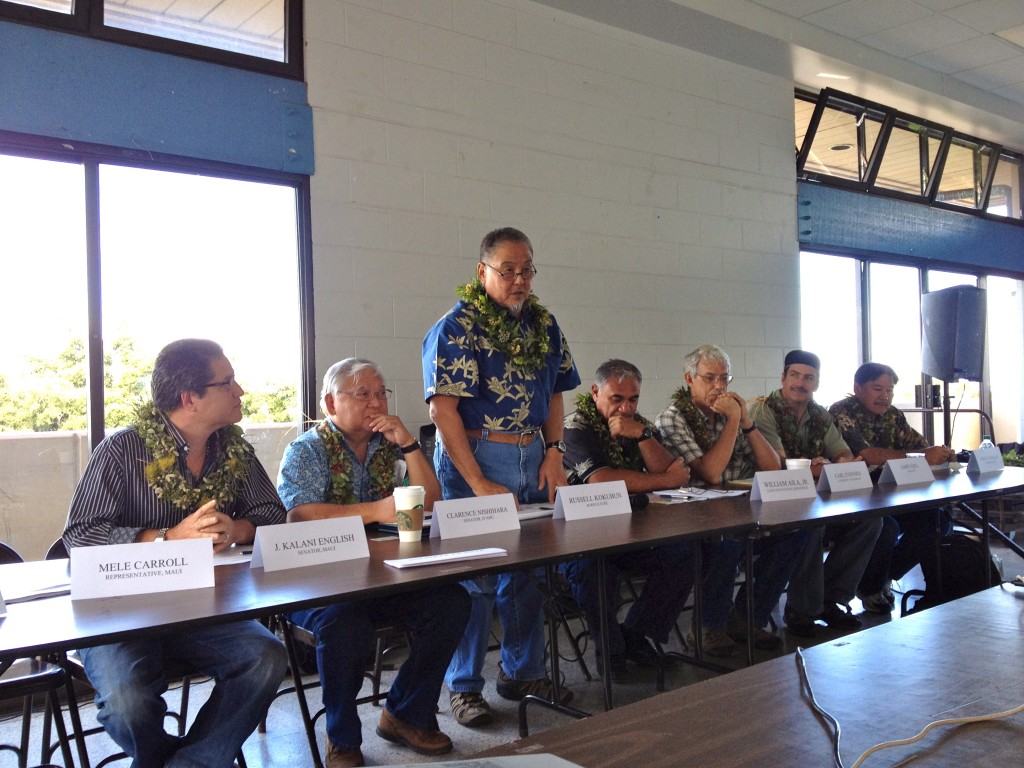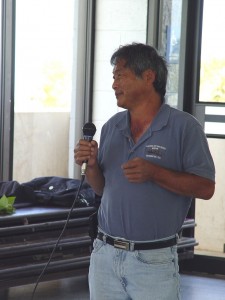The HISC visits Maui
Posted on May 8, 2012 in News
HISC members and participants address an audience in Pukalani, Maui in May, 2012. L to r: Sen. J Kalani English, Sen Clarence Nishihara, Russell Kokubun (HDOA), William J. Aila, Jr. (DLNR), Dr. Carl Evensen (UH), Gary Gill (DOH), and Ford Fuchigami (DOT). Photo: Josh Atwood
In May 2012, the Hawaii Invasive Species Council held its first neighbor-island meeting in the history of the organization on Maui. HISC members were joined by Senators J. Kalani English and Clarence Nishihara, as well as Loyal Mehrhoff of the U.S. Fish and Wildlife Service. The group met at the Hannibal Tavares Community Center in Pukalani to discuss, among other issues, the growing problem of axis deer on Maui Island.
Council members were addressed by Mayor Alan Arakawa, who thanked the Council for making the trip from Honolulu but said that such a meeting should have happened years ago. In the past several decades, the number of axis deer on Maui Island have dramatically increased, causing damage to crops and grazing lands and increasing the risk of automobile collisions.
Maui County Agricultural Specialist Kenneth Yamamura estimated that, over a two year period, axis deer in Maui County have caused over $1M in damage to farms, ranches, and resorts. He further estimated that over $500,000 had been spent during that same two year period to remove or exclude the deer.
The Council was also addressed by Warren Watanabe of the Hawaii Farm Bureau Federation, who had been working with an ad-hoc Maui Axis Deer Working Group. The Working Group is in the process of developing a plan to assess and manage the axis deer population on Maui. Council members urged Mr. Watanabe to submit a request for funding from the HISC to facilitate their efforts.
The Council heard a presentation from Charles Chimera of the Hawaii-Pacific Weed Risk Assessment (HPWRA), a project funded by the HISC. The HPWRA provides the only quantitative method for assessing the potential for a given plant species to be invasive in Hawaii, using natural history information from peer-reviewed publications.
Following the meeting, Council members visited the baseyard for the Maui Invasive Species Committee in Makawao, where they learned about MISC’s projects and received a tutorial on Herbicide Ballistic Technology (HBT) from Dr. James Leary of the University of Hawaii. The HBT platform is designed to strategically deliver a small amount of herbicide to invasive plants in steep areas that cannot be managed on foot. The herbicide is placed in a silicone projectile that can be fired from a paintball gun. The new technology has proven very useful in controlling invasive plants on cliffs and other difficult-to-reach areas, and has the potential to decrease the amount of herbicide used in control operations.
Finally, Council members visited the farm of Wayne Kimura in Kula, where they saw firsthand the damage that axis deer can cause to crops. Mr. Kimura showed the Council his avacados, which needed to be individually fenced in order to keep them from the deer. Mr. Kimura had previously built a fence around his farm to keep out other nonnative ungulates like goats and sheep, but because deer are capable of jumping to great heights, he said he would have install a new fence at least eight feet tall.

An avacado plant browsed by axis deer, on a farm in Kula, Maui. Photo: Josh Atwood

HISC members and partners on a farm in Kula, Maui. L to r: Warren Watanabe, Senator Nishihara, Wayne Kimura, Rob Parsons, Adam Radford, Keren Gundersen, Teya Penniman, William J. Aila, Jr., Russell Kokubun, Dr. Carl Evensen, Dr. Joshua Atwood, Randy Bartlett, Senator J. Kalani English, Gary Gill, Ford Fuchigami, Forest Starr, Kim Starr
